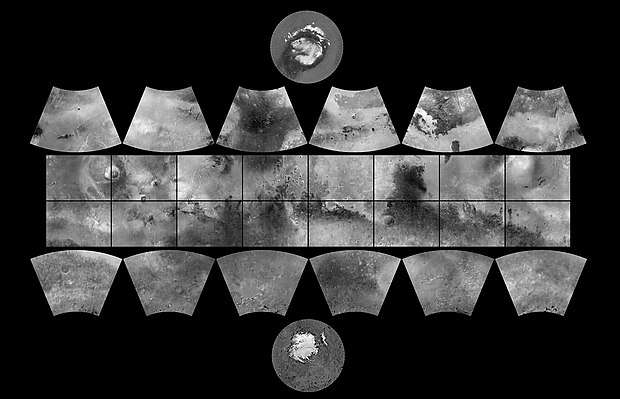Syrtis Major quadrangle
The Syrtis Major quadrangle is one of a series of 30 quadrangle maps of Mars used by the United States Geological Survey (USGS) Astrogeology Research Program. The Syrtis Major quadrangle is also referred to as MC-13 (Mars Chart-13).[1]
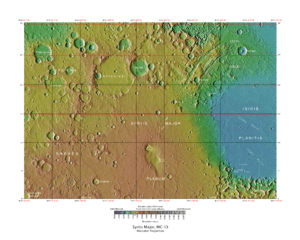 Map of Syrtis Major quadrangle from Mars Orbiter Laser Altimeter (MOLA) data. The highest elevations are red and the lowest are blue. | |
| Coordinates | 15°N 292.5°W |
|---|---|

The quadrangle covers longitudes 270° to 315° west and latitudes 0° to 30° north on Mars. Syrtis Major quadrangle includes Syrtis Major Planum and parts of Terra Sabaea and Isidis Planitia.
Syrtis Major is an old shield volcano with a central depression that is elongated in a north-south direction. It contains the calderas Meroe Patera and Nili Patera.[2] Interesting features in the area include dikes and inverted terrain.
The Beagle 2 lander was about to land near the quadrangle, particularly in the eastern part of Isidis Planitia, in December 2003, when contact with the craft was lost. In January 2015, NASA reported the Beagle 2 had been found on the surface in Isidis Planitia (location is about 11.5265°N 90.4295°E).[3][4] High-resolution images captured by the Mars Reconnaissance Orbiter identified the lost probe, which appears to be intact.[5][6][7] (see discovery images here)
In November 2018, NASA announced that Jezero crater was chosen as the landing site for the planned Mars 2020 rover mission.[8][9] Jezero crater is in the Syrtis Major quadrangle at (at 18.855°N 77.519°E)[10]
Discovery and name
The name Syrtis Major is derived from the classical Roman name Syrtis maior for the Gulf of Sidra on the coast of Libya (classical Cyrenaica). It is near Cyrene which is the place where "Simon" who carried the cross of Jesus was from.[11][12][13]
Syrtis Major was the first documented surface feature of another planet. It was discovered by Christiaan Huygens, who included it in a drawing of Mars in 1659. The feature was originally known as the Hourglass Sea but has been given different names by different cartographers. In 1840, Johann Heinrich von Mädler compiled a map of Mars from his observations and called the feature Atlantic Canale. In Richard Proctor's 1867 map it is called then Kaiser Sea (after Frederik Kaiser of the Leiden Observatory). Camille Flammarion called it the Mer du Sablier (French for "Hourglass Sea") when he revised Proctor's nomenclature in 1876. The name "Syrtis Major" was chosen by Giovanni Schiaparelli when he created a map based on observations made during Mars' close approach to Earth in 1877.[14][15]
Igneous rocks
Syrtis Major is of great interest to geologists because several types of igneous rocks have been found there with orbiting spacecraft. Besides basalt, dacite and granite have been found there. Dacite originates under volcanoes in magma chambers. Dacites form at the top of the chamber, after heavy minerals (olivine and pyroxene) containing iron and magnesium have settled to the bottom. Granite is formed by an even more complex process.[16]
Some areas of Syrtis Major contain large amounts of the mineral olivine. Olivine turns into other minerals very rapidly in the presence of water, so a high abundance of olivine suggests that for a long time little water has been there.[17]
Minerals
A variety of important minerals have been discovered near Nili Fossae, a major trough system in Syrtis major. Besides a large exposure of olivine located in Nili Fossae. Other minerals found there include carbonates, aluminum smectite, iron/magnesium smectite, hydrated silica, kaolinite group minerals, and iron oxides.[18][19] In December 2008, NASA's Mars Reconnaissance Orbiter found that rocks at Nili Fossae contain carbonate minerals, a geologically significant discovery.[20][21][22] Later research published in October 2010, described a large deposit of carbonate rocks found inside Leighton Crater at a level that was once buried 4 miles (6 km) below the surface. Finding carbonates in an underground location strongly suggests that Mars was warmer and had more atmospheric carbon dioxide and ancient seas. Because the carbonates were near silicate minerals and clays hydrothermal systems like the deep sea vents on Earth may have been present.[23][24]
Other minerals found by the MRO are aluminum smectite, iron/magnesium smectite, hydrated silica, kaolinite group minerals, iron oxides, and talc.[19][24] NASA scientists discovered that Nili Fossae is the source of plumes of methane, raising the question of whether this source originates from biological sources.[25][26]
Research published in the fall of 2010, describes the discovery of hydrated silica on the flanks of a volcanic cone. The deposit was from a steam fumarole or hot spring, and it represents a recent habitable microenvironment. The 100-meter-high (330 ft) cone rests on the floor of Nili Patera. Observations were obtained with NASA's Mars Reconnaissance Orbiter.[27]
Dikes
Narrow ridges occur in some places on Mars. They may be formed by different means, but some are probably caused by molten rock moving underground, cooling into hard rock, then being exposed by the erosion of softer, surrounding materials. Such a feature is termed a dike. They are common on Earth—some famous ones are Shiprock, New Mexico;[28] around Spanish Peaks, Colorado;[29][30] and the "Iron Dike" in Rocky Mountain National Park, Colorado.[31]
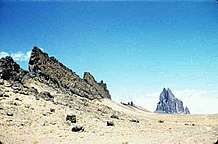 Dikes near Shiprock, New Mexico
Dikes near Shiprock, New Mexico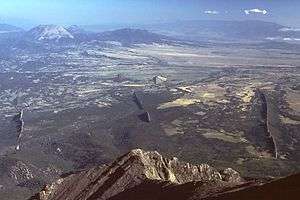 WestSpanishPeak, CO
WestSpanishPeak, CO
The discovery on Mars of dikes that were formed from molten rock is highly significant because dikes indicate the existence of intrusive igneous activity. On the Earth such activity is associated with precious metals like gold, silver, and tellurium.[32] Dikes and other intrusive structures are common in the Cripple Creek Mining District of Colorado;[32] the Battle Mountain-Eureka area in north-central Nevada, famous for gold and molybdenum deposits;[33] and around the Franklin dike swarm in Canada. Mapping the presence of dikes allows us to understand how magma (molten rock under the ground) travels and where it could have interacted with surrounding rock, thus producing valuable ores. Deposits of important minerals are also made by dikes and other igneous intrusions heating water which then dissolves minerals that are deposited in cracks in nearby rock.[34] One would expect a great deal of intrusive igneous activity to occur on Mars because it is believed there is more igneous activity under the ground than on top, and Mars has many huge volcanoes.[35]
 Possible dike, as seen by HiRISE under HiWish program
Possible dike, as seen by HiRISE under HiWish program- Box outlines area in next image from HiRISE. Knobs and mesas were probably formed from the erosion of deposits in an old crater.
- Possible dike from HiRISE under the HiWish program
Linear ridge networks
Some crater floors in the Syrtis Major area show elongated ridges in a lattice-like pattern. Such patterns are typical of faults and breccia dikes formed as a result of an impact. Some have suggested that these linear ridge networks are dikes made up of molten rock; others have advanced the idea that other fluids such as water were involved.[36] The ridges are found where there has been enhanced erosion. Pictures below show examples of these dikes. Water may flow along faults. The water often carries minerals that serve to cement rock materials thus making them harder. Later when the whole area undergoes erosion the dikes will remain as ridges because they are more resistant to erosion.[37] This discovery may be of great importance for future colonization of Mars because these types of faults and breccia dikes on earth are associated with key mineral resources.[38][39] It has been estimated that 25% of the Earth's impacts are connected to mineral production.[40] The largest gold deposit on Earth is the Vredefort 300 km diameter impact structure in South Africa.[41] Perhaps, when people live on Mars these kinds of areas will be mined as they are on earth.[42]
- Huo Hsing Vallis in Syrtis Major, as seen by THEMIS. Straight ridges may be dikes in which liquid rock once flowed.
- Huo Hsing Vallis Ridges, as seen by HiRISE. Ridges may be caused by water moving along faults.
 Ridges, as seen by HiRISE under HiWish program These may be the result of dikes or faults.
Ridges, as seen by HiRISE under HiWish program These may be the result of dikes or faults.
 Ridge network, as seen by HiRISE under HiWish program
Ridge network, as seen by HiRISE under HiWish program Ridges near the previous image of a ridge network, as seen by HiRISE under HiWish program Arrows point to some ridges.
Ridges near the previous image of a ridge network, as seen by HiRISE under HiWish program Arrows point to some ridges. Ridges, as seen by HiRISE under HiWish program
Ridges, as seen by HiRISE under HiWish program Close view of ridges, as seen by HiRISE under HiWish program
Close view of ridges, as seen by HiRISE under HiWish program Close, color view of ridges, as seen by HiRISE under HiWish program
Close, color view of ridges, as seen by HiRISE under HiWish program
 Wide view of ridges, as seen by HiRISE under HiWish program
Wide view of ridges, as seen by HiRISE under HiWish program Close, color view of ridges, as seen by HiRISE under HiWish program
Close, color view of ridges, as seen by HiRISE under HiWish program
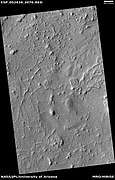 Wide view of ridge networks, as seen by HiRISE under HiWish program
Wide view of ridge networks, as seen by HiRISE under HiWish program Close view of ridge networks, as seen by HiRISE under HiWish program
Close view of ridge networks, as seen by HiRISE under HiWish program
 Ridges, as seen by HiRISE under HiWish program
Ridges, as seen by HiRISE under HiWish program Close color view of ridges, as seen by HiRISE under HiWish program
Close color view of ridges, as seen by HiRISE under HiWish program Wide view of ridges, as seen by HiRISE under HiWish program
Wide view of ridges, as seen by HiRISE under HiWish program Close, color view of ridges, as seen by HiRISE under HiWish program
Close, color view of ridges, as seen by HiRISE under HiWish program Close, color view of ridges, as seen by HiRISE under HiWish program
Close, color view of ridges, as seen by HiRISE under HiWish program
Buttes
Many places on Mars have buttes that are similar to buttes on Earth, such as the famous ones in Monument Valley, Utah. Buttes are formed when most of a layer(s) of rocks are removed from an area. Buttes usually have a hard, erosion resistant cap rock on the top. The cap rock causes the top of a butte to be flat. An example of a butte in the Syrtis Major quadrangle is shown below.
- Auqakuh Vallis. At one time a dark layer covered the whole area, now only a few pieces remain as buttes. Image was taken with THEMIS.
Dunes
Sand dunes are found all over Mars. Often sand dunes will form in low areas, for example on the floor of ancient river valleys. Dunes on the floor of Arnus Vallis, an old river valley are visible in a picture below. Dunes in valleys on Mars usually lie at right angles to the valley walls.
- Arnus Vallis layers, as seen by HiRISE
 Wide view of dunes, as seen by HiRISE under HiWish program
Wide view of dunes, as seen by HiRISE under HiWish program Dunes, as seen by HiRISE under HiWish program
Dunes, as seen by HiRISE under HiWish program Close view of dunes, as seen by HiRISE under HiWish program
Close view of dunes, as seen by HiRISE under HiWish program
Streaks
Many areas of Mars change their shape and/or coloration. For many years, astronomers observing regular changes on Mars when the seasons changed, thought that what they saw was evidence of vegetation growing. After close-up inspection with a number of spacecraft, other causes were discovered. Basically, the changes are caused by the effects of the wind blowing dust around. Sometimes, fine bright dust settles on the dark basalt rock making the surface appear lighter, at other times the light-toned dust will be blown away; thus making the surface darken—just as if vegetation were growing. Mars has frequent regional or global dust storms that coat the surface with fine bright dust. In the THEMIS image below, white streaks are seen downwind of craters. The streaks are not too bright; they appear bright because of contrast with the dark volcanic rock basalt which makes up the surface.[43]
- Bright Streaks in Syrtis Major caused by the wind, as seen by THEMIS.
 Light-toned streak on the lee ward side of a crater, as seen by HiRISE under HiWish program
Light-toned streak on the lee ward side of a crater, as seen by HiRISE under HiWish program
Inverted relief
Some places on Mars show inverted relief. In these locations, a stream bed may be a raised feature, instead of a valley. The inverted former stream channels may be caused by the deposition of large rocks or due to cementation. In either case erosion would erode the surrounding land and leave the old channel as a raised ridge because the ridge would be more resistant to erosion. Images below, taken with HiRISE show sinuous ridges that are old channels that have become inverted.[44]
- Inverted Stream Channels in Antoniadi Crater, as seen by HiRISE
 Inverted Channel with many branches in Syrtis Major quadrangle
Inverted Channel with many branches in Syrtis Major quadrangle Possible inverted streams, as seen by HiRISE under HiWish program
Possible inverted streams, as seen by HiRISE under HiWish program
Methane
For several years, researchers have found methane in the atmosphere of Mars. After study, it was determined to be coming from a point in Syrtis Major, located at 10° N and 50° E.[45] A recent study indicates that to match the observations of methane, there must be something that quickly destroys the gas, otherwise it would be spread all through the atmosphere instead of being concentrated in one location. There may be something in the soil that oxidizes the gas before it has a chance to spread. If this is so, that same chemical would destroy organic compounds, thus life would be very difficult on Mars.[46]
Layers
Many places on Mars show rocks arranged in layers. Rock can form layers in a variety of ways. Volcanoes, wind, or water can produce layers.[47] A detailed discussion of layering with many Martian examples can be found in Sedimentary Geology of Mars.[48]
 Wide view of rock layers, as seen by HiRISE under HiWish program
Wide view of rock layers, as seen by HiRISE under HiWish program Tilted rock layers, as seen by HiRISE under HiWish program
Tilted rock layers, as seen by HiRISE under HiWish program Rock layers in Flammarion (Martian crater), as seen by HiRISE under HiWish program
Rock layers in Flammarion (Martian crater), as seen by HiRISE under HiWish program Close view of layers, as seen by HiRISE under HiWish program Part of the image is in color. HiRISE images only show a middle part in color.
Close view of layers, as seen by HiRISE under HiWish program Part of the image is in color. HiRISE images only show a middle part in color.
 Wide view of layers, as seen by HiRISE under HiWish program
Wide view of layers, as seen by HiRISE under HiWish program Layers around crater, as seen by HiRISE under HiWish program
Layers around crater, as seen by HiRISE under HiWish program
 Layers, as seen by HiRISE under HiWish program
Layers, as seen by HiRISE under HiWish program Layers, as seen by HiRISE under HiWish program
Layers, as seen by HiRISE under HiWish program
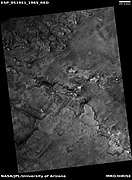 Wide view of layers, as seen by HiRISE under HiWish program
Wide view of layers, as seen by HiRISE under HiWish program Close view of layers, as seen by HiRISE under HiWish program
Close view of layers, as seen by HiRISE under HiWish program
Channels
There is enormous evidence that water once flowed in river valleys on Mars.[49][50] Images of curved channels have been seen in images from Mars spacecraft dating back to the early seventies with the Mariner 9 orbiter.[51][52][53][54] Indeed, a study published in June 2017, calculated that the volume of water needed to carve all the channels on Mars was even larger than the proposed ocean that the planet may have had. Water was probably recycled many times from the ocean to rainfall around Mars.[55][56]
 Channel, as seen by HiRISE under HiWish program
Channel, as seen by HiRISE under HiWish program Peridier Crater, as seen by CTX camera (on Mars Reconnaissance Orbiter).
Peridier Crater, as seen by CTX camera (on Mars Reconnaissance Orbiter).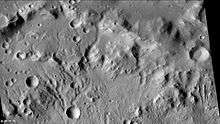 Channels along wall of Peridier Crater, as seen by CTXcamera (on Mars Reconnaissance Orbiter). Note: this is an enlargement of the previous image of Peridier Crater.
Channels along wall of Peridier Crater, as seen by CTXcamera (on Mars Reconnaissance Orbiter). Note: this is an enlargement of the previous image of Peridier Crater. Channel, as seen by HiRISE under HiWish program
Channel, as seen by HiRISE under HiWish program Channel, as seen by HiRISE under HiWish program
Channel, as seen by HiRISE under HiWish program Channels, as seen by HiRISE under HiWish program
Channels, as seen by HiRISE under HiWish program Valleys, as seen by HiRISE under HiWish program
Valleys, as seen by HiRISE under HiWish program Channels and ridges, as seen by HiRISE under HiWish program
Channels and ridges, as seen by HiRISE under HiWish program Close view of ridges, as seen by HiRISE under HiWish program
Close view of ridges, as seen by HiRISE under HiWish program
Hollows
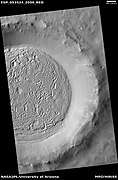 Hollows that formed in crater floor deposit, as seen by HiRISE under HiWish program Hollows probably formed as ice left the ground.
Hollows that formed in crater floor deposit, as seen by HiRISE under HiWish program Hollows probably formed as ice left the ground. Close, color view of hollows on crater floor, as seen by HiRISE under HiWish program many cracks are visible. Ground rich in ice often forms cracks. When a crack appears, there is enhanced loss of ice from the ground. Eventually, a small crack may evolve into a hollow.
Close, color view of hollows on crater floor, as seen by HiRISE under HiWish program many cracks are visible. Ground rich in ice often forms cracks. When a crack appears, there is enhanced loss of ice from the ground. Eventually, a small crack may evolve into a hollow.- Eroding mesa in Syrtis Major. It would be rough to walk across this feature. Image was taken with Mars Global Surveyor, under the MOC Public Targeting Program.
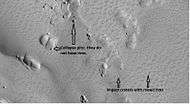 Close-up of crater deposit that shows both impact craters and pit craters caused by collapse. Image taken by HiRISE under the HiWish program.
Close-up of crater deposit that shows both impact craters and pit craters caused by collapse. Image taken by HiRISE under the HiWish program.
 Crater with eroding floor deposit, as seen by HiRISE under HiWish program
Crater with eroding floor deposit, as seen by HiRISE under HiWish program Close view of pits forming in crater floor deposit. The box shows the size of a football field for scale.
Close view of pits forming in crater floor deposit. The box shows the size of a football field for scale.
Other features in Syrtis major quadrangle
 End moraine of a glacier, as seen by HiRISE under HiWish program
End moraine of a glacier, as seen by HiRISE under HiWish program Wide view of mesa breaking up into rocks, as seen by HiRISE under HiWish program Parts of this image are shown enlarged in the next two images.
Wide view of mesa breaking up into rocks, as seen by HiRISE under HiWish program Parts of this image are shown enlarged in the next two images. Crossing joints, as seen by HiRISE under HiWish program
Crossing joints, as seen by HiRISE under HiWish program Rocks forming, as seen by HiRISE under HiWish program
Rocks forming, as seen by HiRISE under HiWish program Patterned ground, as seen by HiRISE under HiWish program
Patterned ground, as seen by HiRISE under HiWish program Color view of mesas, as seen by HiRISE under HiWish program
Color view of mesas, as seen by HiRISE under HiWish program Color view of mesa breaking up into boulders, as seen by HiRISE under HiWish program
Color view of mesa breaking up into boulders, as seen by HiRISE under HiWish program Polygons shapes in surface, as seen by HiRISE under HiWish program
Polygons shapes in surface, as seen by HiRISE under HiWish program Tilted mesa, as seen by HiRISE under HiWish program
Tilted mesa, as seen by HiRISE under HiWish program Crater with bench, as seen by HiRISE under HiWish program
Crater with bench, as seen by HiRISE under HiWish program
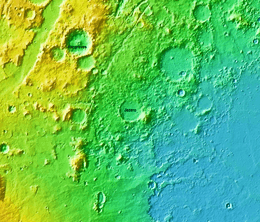 Jezero crater and region
Jezero crater and region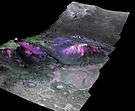 Water-rich terrain
Water-rich terrain- Possible channel bringing sediment to the crater
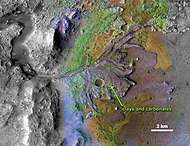 Jezero crater delta - chemical alteration by water (hi-res)
Jezero crater delta - chemical alteration by water (hi-res) Detected clay materials suggest an ancient lake
Detected clay materials suggest an ancient lake
Other Mars quadrangles
Interactive Mars map
See also
References
- Davies, M.E.; Batson, R.M.; Wu, S.S.C. "Geodesy and Cartography" in Kieffer, H.H.; Jakosky, B.M.; Snyder, C.W.; Matthews, M.S., Eds. Mars. University of Arizona Press: Tucson, 1992.
- http://www.daviddarling.info/encyclopedia/S/SyrtisMajor.html
- Ellison, Doug (16 January 2015). "re Beagle 2 location on Mars => "Using HiView on image ESP_039308_1915_COLOR.JP2 I get 90.4295E 11.5265N"". Twitter & JPL. Retrieved 19 January 2015.
- Grecicius, Tony; Dunbar, Brian (16 January 2015). "Components of Beagle 2 Flight System on Mars". NASA. Retrieved 18 January 2015.
- Webster, Guy (16 January 2015). "'Lost' 2003 Mars Lander Found by Mars Reconnaissance Orbiter". NASA. Retrieved 16 January 2015.
- "Mars Orbiter Spots Beagle 2, European Lander Missing Since 2003". New York Times. Associated Press. 16 January 2015. Retrieved 17 January 2015.
- Amos, Jonathan (16 January 2015). "Lost Beagle2 probe found 'intact' on Mars". BBC. Retrieved 16 January 2015.
- Wall, Mike (19 November 2018). "Jezero Crater or Bust! NASA Picks Landing Site for Mars 2020 Rover". Space.com. Retrieved 20 November 2018.
- Mandelbaum, Ryan F. "NASA's Mars 2020 Rover Will Land in Jezero Crater". Gizmodo. Retrieved 2018-11-19.
- Wray, James (6 June 2008). "Channel into Jezero Crater Delta". NASA. Retrieved 6 March 2015.
- https://ferrelljenkins.wordpress.com/2011/03/30/libya-and-the-bible-%E2%80%94-more-than-you-think/
- https://books.google.com/books?id=3JNQAQAAMAAJ&pg=PA18 The Cambridge Bible for Schools and Colleges, Volume 59
- Gleig, G. and T. Stackhouse. A History of the holy Bible, corrected and improved. https://books.google.com/books?id=jVIOAAAAQAAJ&pg=PA286
- Morton, Oliver (2002). Mapping Mars: Science, Imagination, and the Birth of a World. New York: Picador USA. pp. 14–15. ISBN 0-312-24551-3.
- William Sheehan. "The Planet Mars: A History of Observation and Discovery - Chapter 4: Areographers". Retrieved 2007-09-07.
- Christensen, P. 2005. "The Many Faces of Mars". Scientific American. July, 2005.
- http://www.marsdaily.com/news-odyssey-05a.html
- "Nasa finds 'missing' Mars mineral"
- Murchie, S. et al. 2009. "A synthesis of Martian aqueous mineralogy after 1 Mars year of observations from the Mars Reconnaissance Orbiter". Journal of Geophysical Research: 114. E00D06.
- NASA finds 'missing' Mars mineral
- http://www.space.com/30746-mars-missing-atmosphere-lost-in-space.html
- Edwards, C., B. Ehlmann. 2015. "Carbon sequestration on Mars". Geology: doi: 10.1130/G36983.1.
- http://www.astrobio.net/pressrelease/3646/exposed-rocks-point-to water-on-ancient-mars
- 1.Adrian J. Brown, Simon J. Hook, Alice M. Baldridge, James K. Crowley, Nathan T. Bridges, Bradley J. Thomson, Giles M. Marion, Carlos R. de Souza Filho, Janice L. Bishop. "Hydrothermal formation of Clay-Carbonate alteration assemblages in the Nili Fossae region of Mars". Earth and Planetary Science Letters, 2010; doi:10.1016/j.epsl.2010.06.018
- Mars Methane Found, Raising Possibility of Life
- New light on Mars methane mystery
- http://www.spaceref.com/news/viewpr.html?pid=31980
- http://www.msss.com/mars_images/moc/2005/10/13/
- Chronic, Halka (January 1980). Roadside Geology of Colorado. ISBN 0-87842-105-X.
- Blatt, Harvey; Tracy, Robert (1995-12-15). Petrology, Second Edition: Igneous, Sedimentary, and Metamorphic. ISBN 0-7167-2438-3.
- ISBN 0-8403-4619-0
- http://ccvgoldmining.com/Geology/geology.html
- http://www.mirandagold.com/s/Coal/Canyon.asp
- Namowitz, S. and D. Stone. 1975. Earth Science-The World We Live In. American Book Company. Ny, NY
- Crisp, J. 1984. "Rates of magma emplacement and volcanic output". J. Volcanlo. Geotherm. Res: 20. 177-211.
- Saper, L., J. Mustard. 2013. "Extensive linear ridge networks in Nili Fossae and Nilosyrtis, Mars: implications for fluid flow in the ancient crust". Geophysical Research Letters: 40, 245-249.
- http://hirise.lpl.arizona.edu/PSP_008189_2080
- http://news.discovery.com/space/mars-prospecting-ores-gold.html
- West, M. and J. Clarke. 2010. Potential Martian Resources: Mechanisms and Terrestrial Analogues: 58. 574-582
- Mory, H.J. et al. 2000. "Woodleigh Carnarvon Basin, Western Australia: a new 120 km diameter impact structure". Earth and Planetary Science Letters: 177. 119-128
- Evens, K et al. 2005. The Sedimentary Record of Meteorite Impacts: An SEPM Research Conference. The Sedimentary Record: 3. 4-8.
- Head, J. and J. Mustard. 2006. "Breccia Dikes and Crater-Related Faults in Impact Craters on Mars: Erosion and Exposure on the Floor of a 75-km Diameter Crater at the Dichotomy Boundary". In Special Issue on Role of Volatiles and Atmospheres on Martian Impact Craters Meteoritics & Planetary Science.
- http://themis.asu.edu/zoom-20020606a
- http://hiroc.lpl.arizona.edu/images/PSP/diafotizo.php?ID=PSP_002279_1735
- http://www.space.com/scienceastronomy/mars-methane-gas-disappears-quickly-100920.html
- http://www.spaceref.com:80/news/viewpr.html?pid=28914
- "HiRISE | High Resolution Imaging Science Experiment". Hirise.lpl.arizona.edu?psp_008437_1750. Retrieved 2012-08-04.
- Grotzinger, J. and R. Milliken (eds.). 2012. Sedimentary Geology of Mars. SEPM.
- Baker, V., et al. 2015. "Fluvial geomorphology on Earth-like planetary surfaces: a review". Geomorphology. 245, 149–182.
- Carr, M. 1996. in Water on Mars. Oxford Univ. Press.
- Baker, V. 1982. The Channels of Mars. Univ. of Tex. Press, Austin, TX
- Baker, V., R. Strom, R., V. Gulick, J. Kargel, G. Komatsu, V. Kale. 1991. "Ancient oceans, ice sheets and the hydrological cycle on Mars". Nature 352, 589–594.
- Carr, M. 1979. "Formation of Martian flood features by release of water from confined aquifers". J. Geophys. Res. 84, 2995–300.
- Komar, P. 1979. "Comparisons of the hydraulics of water flows in Martian outflow channels with flows of similar scale on Earth". Icarus 37, 156–181.
- http://spaceref.com/mars/how-much-water-was-needed-to-carve-valleys-on-mars.html
- Luo, W., et al. 2017. "New Martian valley network volume estimate consistent with ancient ocean and warm and wet climate". Nature Communications 8. Article number: 15766 (2017). doi:10.1038/ncomms15766
- Staff (4 March 2015). "PIA19303: A Possible Landing Site for the 2020 Mission: Jezero Crater". NASA. Retrieved 7 March 2015.
- Morton, Oliver (2002). Mapping Mars: Science, Imagination, and the Birth of a World. New York: Picador USA. p. 98. ISBN 0-312-24551-3.
- "Online Atlas of Mars". Ralphaeschliman.com. Retrieved December 16, 2012.
- "PIA03467: The MGS MOC Wide Angle Map of Mars". Photojournal. NASA / Jet Propulsion Laboratory. February 16, 2002. Retrieved December 16, 2012.
- "Online Atlas of Mars". Ralphaeschliman.com. Retrieved December 16, 2012.
- "PIA03467: The MGS MOC Wide Angle Map of Mars". Photojournal. NASA / Jet Propulsion Laboratory. February 16, 2002. Retrieved December 16, 2012.
